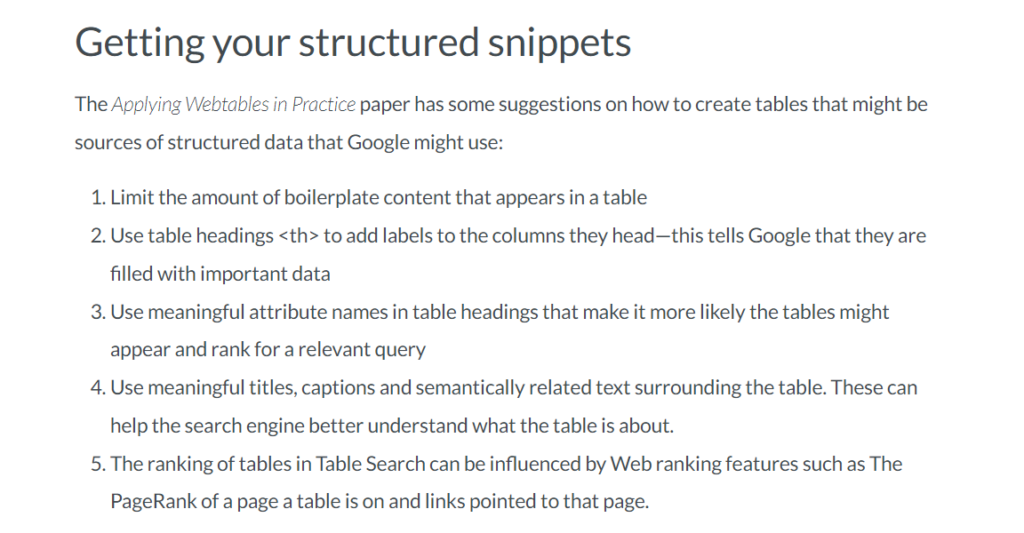How Google Pulls Structured Snippets from Websites Tables

Google’s structured snippets have emerged as an essential instrument for increasing user experience and presenting succinct information immediately in search results in the ever-changing world of search engine optimization (SEO) and search engine result pages (SERPs). Frequently pulled from page tables, these snippets give consumers short answers to their questions. This blog digs into how Google extracts structured snippets from webpage tables, shedding light on the magic behind this feature.
What is Table Search?
While searching for information on literally anything on the internet, you will come across many websites containing data in the form of tables. Many of you might have missed Google Table Search if inattentively searching for data on the web. You need not get frustrated since there was not much news and press done about Google Table Search. The entire concept revolves around including tabular data on the pages of your website that will be included in the results from a query in Google Table Search.
For example, I am willing to buy a television, and not sure which one to buy. I have heard many good things about Samsung LED TV and LCD TV, so I go to Table Search and look for LED TV Samsung. The first table gives me some choices to compare different televisions.
Table Search and Structured Snippets
One interesting aspect of Google’s Table Search is the structured snippet, which is a search result that is a combination of query results and tabular data results. It is worth of remembering that Structured Snippets is now a part of Google Web Search! For example, typing Spiderman on Google will return your facts from a Wikipedia table about the character. Those additional facts come from the table associated with a query on Spiderman.

Source – https://moz.com/blog/google-structured-snippets
The Evolution of Structured Snippets:
Structured snippets are a representation of Google’s commitment to improving search results. They serve as concise summaries of information extracted from web pages that align with users’ search queries. These snippets aim to provide users with immediate answers to specific questions, saving time and enhancing the search experience.
-
Table Extraction Algorithm:
Google employs advanced algorithms to analyze web pages and extract relevant table information. When a user’s query is closely related to tabular data, Google’s algorithms identify and extract tables from web pages that contain pertinent information. This process involves understanding the context of the table, its headers, rows, and the significance of the data within.
-
Semantic Understanding:
Google’s algorithms go beyond simple keyword matching. They incorporate Semantic understanding to comprehend the meaning and context of the data in the table. This enables Google to provide more accurate and relevant structured snippets directly addressing the user’s query.
-
Structured Data Markup:
Structured data markup is pivotal in extracting structured snippets from website tables. Websites implementing structured data markup provide clear, organized information that Google’s algorithms can solve more effectively.
-
User Intent Alignment:
Google’s structured snippets are driven by user intent. The algorithm seeks to understand the user’s query and its intent. When a user seeks specific information that can be presented in a tabular format, Google identifies and extracts relevant tables to create structured snippets.
-
Data Validation and Accuracy:
Google’s extraction process incorporates data validation mechanisms to ensure the accuracy and reliability of extracted information. This ensures that the structured snippets presented to users are trustworthy and provide valuable insights.
-
Mobile and User-Friendly Display:
Structured snippets are designed to enhance the mobile user experience. The extracted data is displayed in a user-friendly format, making it easily scannable and accessible, even on smaller screens.
Also, Read –
Google Ad Rank and The Proven Ways To Improve It
How to Find Structured Data Markup Errors & Fix it
The Benefits of Structured Snippets:
Structured snippets offer a range of benefits to both users and website owners:
Enhanced User Experience: Structured snippets provide immediate answers to users’ queries, reducing the need to click through to multiple pages.
Increased Visibility: Websites with structured snippets enjoy enhanced visibility in search results, standing out and capturing users’ attention.
Improved Click-Through Rates: The concise and relevant information displayed in structured snippets entices users to click on the website for more details.
Brand Authority: Websites that consistently provide accurate and valuable structured snippets establish themselves as authoritative sources of information.
Conclusion:
Structured snippets from Google blend art and science, where powerful algorithms and semantic understanding merge to give consumers concise and relevant information. The extraction of structured snippets from page tables demonstrates Google’s dedication to improving the search experience and providing people with instant answers. Understanding the principles of structured snippets helps website owners optimize their content and markup to fit with Google’s extraction process, ensuring that the information on their website is successfully delivered to people looking for quick answers to their questions. The beauty of structured snippets brings efficiency and ease to the search experience in this digital era, benefiting users and page owners.